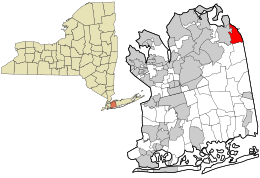Mayor of Laurel Hollow, New York
| Laurel Hollow, New York | |
|---|---|
| Village | |
| Village of Laurel Hollow | |
 Location in Nassau County and the state of New York. |
|
| Coordinates: 40°51′25″N 73°28′37″W / 40.85694°N 73.47694°WCoordinates: 40°51′25″N 73°28′37″W / 40.85694°N 73.47694°W | |
| Country |
|
| State |
|
| County | Nassau |
| Government | |
| • Mayor | Dan DeVita |
| Area | |
| • Total | 3.1 sq mi (8.0 km2) |
| • Land | 2.9 sq mi (7.6 km2) |
| • Water | 0.2 sq mi (0.4 km2) |
| Elevation | 240 ft (73 m) |
| Population (2010) | |
| • Total | 1,952 |
| • Estimate (2016) | 2,038 |
| • Density | 630/sq mi (240/km2) |
| Time zone | Eastern (EST) (UTC-5) |
| • Summer (DST) | EDT (UTC-4) |
| ZIP codes | 11771, 11791, 11724 |
| Area code(s) | 516 |
| FIPS code | 36-41487 |
| GNIS feature ID | 0955090 |
| Website | www |
Laurel Hollow is a village in the Town of Oyster Bay in Nassau County, New York in the United States. The population was 1,952 at the 2010 census. According to Bloomberg BusinessWeek, Laurel Hollow is the 8th wealthiest town in America.
Laurel Hollow is served by the Cold Spring Harbor Central School District in Cold Spring Harbor, with a small portion in Oyster Bay-East Norwich School District.
The settlement began around 1653 with purchase of land from the local natives. The village was incorporated in 1926 as "Lauralton," but the name was changed to "Laurel Hollow" in 1935 to avoid confusion with a location in Queens County, New York.
The famous Cold Spring Harbor Laboratory, is located in the village.
Laurel Hollow is located at 40°51′25″N 73°28′37″W / 40.85694°N 73.47694°W (40.856991, -73.477008). The village is situated in Nassau County and creates a portion of Nassau's eastern border with Suffolk County. Hilly terrain predominates in the area, and the forests are mostly deciduous trees with a low canopy of laurel bushes that provide a low evergreen canopy. Route 25A passes through Laurel Hollow east-west.
According to the United States Census Bureau, the village has a total area of 3.1 square miles (8.0 km2), of which 2.9 square miles (7.5 km2) is land and 0.2 square miles (0.52 km2), or 5.18%, is water.
...
Wikipedia

